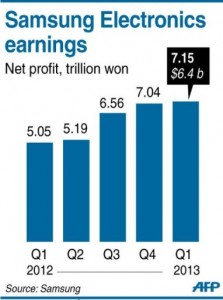
AFP – SEOUL — Samsung on Friday released the latest version of its flagship Galaxy smartphone, as it announced record first-quarter profits driven by surging sales growth in its mobile division.
The Galaxy S4, armed with eye motion control technology that pauses a video when the user looks away, comes with a faster chip and is thinner and lighter than the previous S3 model.
Unveiled last month at New York’s Radio City Music Hall, the touchscreen device hit South Korean stores on Friday ahead of a global roll-out over the weekend.
Samsung said unexpectedly high demand for the new model was behind shipping issues that resulted in the postponement of its scheduled sales release in the US market.
After years of following and refining the iPhone’s pioneering innovations — a strategy that resulted in bitter patent battles — Samsung has dethroned arch-rival Apple as the world’s top smartphone maker.
But mixed reviews for the Galaxy S4 reflect the increased pressure that comes with that title for Samsung to shed its copycat label and show it can match Apple’s creative clout.
“Samsung has entered territory that it hasn’t been in before, and sales of the S4 will show if it can sustain its newfound status in the market,” James Song, analyst at KDB Daewoo Securities, told AFP.
The release of the S4 came as Samsung announced a 41.6 percent year-on-year surge in net profit to a record 7.15 trillion won ($6.4 billion) in the first quarter of 2013.
Operating profit stood at 8.8 trillion won, of which the IT and Mobile Communications division accounted for 6.51 trillion won, with sales of 32.82 trillion won in the three months to March.
Samsung Electronics share price closed down 0.54 percent Friday at 1,486,000 won.
The general critical consensus on the new S4 model is that it lacks the “wow” factor to really set it apart from its market rivals.
“Make no mistake about it, the Galaxy S4 is a great phone, and easily one of the best you can buy right now,” said Business Insider.
“But is it the best phone? No. You’re still much better off with the iPhone 5, or the HTC One if you like Android,” the technology news website said.
While there was general praise for the S4’s performance, especially its screen and camera resolution, reviewers suggested Samsung had largely played it safe in terms of innovation and design.
“The S4 is still made of plastic — lightweight and grippy, but not as classy as the iPhone’s glass or the HTC One’s metal,” the New York Times said.
“All told, nobody at the office will notice that you’ve bought the latest and greatest,” the newspaper said.
But business was brisk at Samsung’s flagship retail store in Seoul’s upscale Gangnam district where the S4 was selling for 890,000 won ($800).
Housewife Hwang Hee-Sun, buying her first Samsung phone, said she had been attracted by the S4’s eye motion and air touch controls, which enable users to accept calls or browse the web with a hand gesture near the screen.
“When you have a young child climbing all over you, it should make things a lot easier. And it’s very light,” said the 30-year-old who also cited the new model’s humidity sensor as a useful childcare device.
College student Kim Yu-Ri was upgrading from a Galaxy S2 she bought more than two years ago.
“I don’t know that it’s that different from the S3, but it’s a big upgrade from my old one, and I want to stick with an Android phone,” Kim said.
An estimated 60 million units of the Galaxy S3 have been sold globally since its release last May, while the first and second editions racked up sales of 25 million and 40 million respectively.
In its earnings statement Friday, Samsung said “sound sales” of the S3 smartphone had aided profit margins, but cautioned that second quarter global demand was “forecast to dampen”.
“We may experience stiffer competition in the mobile business due to expansion of the mid- to low-end smartphone market,” said Senior Vice President Robert Yi.
Apple, which reported Tuesday that its quarterly profit had dipped for the first time in nearly a decade, still commands a profit margin double that of Samsung due to its focus on high-end buyers.
Samsung, by contrast, has built its smartphone business on a shotgun marketing approach that involves a wide range of low- to high-end products and which is now being challenged by cheaper Chinese rivals.




